Engineering Elegant Technique
That Wins
Chris Lewit
As a technician working in the trenches building technique over many decades, I have gained a wealth of experience about how to build world-class modern techniques that look pretty. This third article in the series will share that knowledge and convey my methods on how to engineer elegant techniques that win. (Click Here for Part 1. Click Here for Part 2.)
Whether you are a player, coach or parent-coach, this article conveys some golden nuggets about the technique engineering process.
3 Step Process
Let's say that you want to teach or learn a new stroke, like a forehand, or you want to fix something in your technique or the technique of a student, if you are a coach. Where do you begin? What are the initial steps to take when building or remediating the technique of a stroke? It's a 3 step process. I believe you start first with an analysis of footwork and the body positioning when receiving the ball. Second, at the same time, you evaluate handwork, which is the swing technique.
And third, in this process, you use slow motion video analysis to confirm what you think you are seeing. These three steps are crucial during any technique changing process.
Footwork
Great footwork is inextricably linked to spacing and body posture. Great spacing comes from reading the ball well with the eyes and positioning perfectly with the feet to place the body in the optimal position to receive the ball.
Spacing, or positioning, is a key ingredient for world-class beautiful technique because players need room to execute elastic, fluid strokes with full extension. The opposite of good spacing, a cramped contact point, promotes a tighter arm during the stroke and a stiffer looking swing—not optimal or pretty.
Optimal spacing on groundstrokes allows the body to be in perfect balance to receive the ball enabling ideal posture during the execution. Spacing also promotes range of motion (ROM)—a big part of beautiful technique.
The trunk should always be as straight as possible when executing a tennis stroke. A straight back with excellent posture demonstrates ideal balance and body control during the swing. If you are working on serve technique, the footwork consists of the stance, the landing after the jump, and initial pattern of steps following the landing. An upcoming article will be dedicated to specific footwork techniques.
Djokovic demonstrates great spacing, which fosters an elastic swing with good extension. Note the trunk should be vertical to the ground during groundstrokes.
Handwork
After an initial assessment of footwork and body positioning, handwork is the next area to check and analyze. Handwork means the swing technique. The grip, shape of the backswing, tension of the arm or arms, body coil, angle of the forward swing, evidence of racquet lag, impact point and follow-through, etc. should all be observed and noted. I will outline my checkpoints for all the strokes in an additional upcoming article
Video Analysis
Without video analysis, players and coaches can get lost in the technique building process. Slow motion replay allows players and coaches to follow an evidence based approach to working on technique rather than working off assumptions. Vic Braden, John Yandell, Steve Smith and other forward-thinking tennis coaches pioneered the concept of video stroke analysis years ago.
Using video to make an initial assessment of a player's technique and movement is critical. But it is equally critical in gauging whether technical changes are actually happening and helping the player.
Diagram 2.1: Three Steps When Assessing Technique
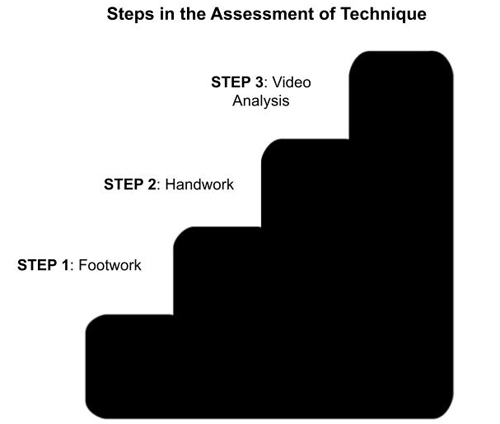
What Techniques First?
When building or rebuilding technique, footwork and movement should be prioritized as well as swings on forehands and backhands. The serve has the next highest priority. Transition shots, net game, and specialty shots have less priority and should be focused on when the player's foundation of serve and groundstrokes is solid. The Winning Pretty Prioritization Triangle (diagram 2.2) shows this approach.
Diagram 2.2: The Winning Pretty Technique Prioritization Triangle
When building technique, prioritize skills at the bottom by following these articles and working your way up!
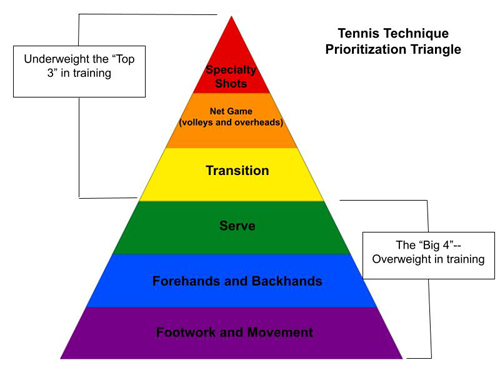
I like to call the most important building blocks in my prioritization triangle the Big Four: footwork and movement, the forehand and backhand, and the serve. These four areas should be overweighted in early developmental training.
The top three skills in the triangle--transition, volleys, overheads, and specialty shots--should be underweighted in training. Players and coaches should work on these areas mainly after the Big Four have been mastered.
Return of Serve
The return of serve is very important at higher levels of the game, where serve speeds are incredibly fast. The return is not included in the technique triangle but should be worked on progressively as players advance in level.
In the initial stages of learning technique, the return of serve is covered by developing solid forehands, backhands, and movement, which are fundamental to returning as well. As players advance in skill level, quicker preparation and shorter ranges of motion on backswings for the return of serve should be practiced specifically and regularly.
Five Stage Technique Building Method
There are five stages of technique building that I have identified and used in the field that have helped my students master techniques. Parents and coaches can use them with their kids or students, or players can follow the method themselves when working on their own game.
Diagram 2.3: The Winning Pretty Five Stages of Technique Building
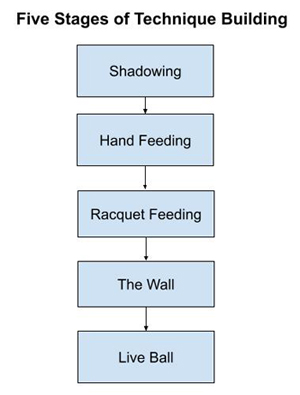
Shadowing
A key element in improving technique and making changes is shadow swinging without a ball. The player can swing many repetitions working on technical checkpoints without worrying about tracking an incoming ball or the result of where the shot is going.
Shadow boxing to work on technique has been a staple of boxing training and the same principles can be applied to tennis. When shadow stroking, the athlete should try to achieve a deep meditative focus and visualize exactly how the technique should look.
Leading American coach Steve Smith is a strong proponent of shadow practice to build techniques. The stroke can be performed in a relatively static way with a stationary stance and then movement can be added to develop the shot mechanics while running or changing directions.
Legendary coach Welby Van Horn was a strong advocate for static swing training focusing on balance and then progressing to movement later in the process. Steve Smith often recommends that students install mirrors in their homes to help provide feedback during technique training.
But shadowing can be performed in front of any reflective surface (like a window or glass door), or by using video analysis to provide more direct visual feedback. Shadowing is a good alternative when a player is struggling to perform the correct motor patterns with the ball to build up the confidence in hitting the technical reference points.
Hitting off a tee or using a device like an Eye Coach, Great Base Backboard, or Topspin Pro, which are all relatively compact swing trainers, are all excellent ways to get a lot of quality practice swings in a short amount of time. Using a device like these is highly recommended as a supplement to on court tennis practice and also on rain days if there is no access to indoor courts.
An effective way to use shadowing is to alternate between hitting the ball and doing a shadow swing to help lock in perfect form and reduce the chance of technical reversion.
There are many benefits to shadow swinging, and I use it all the time when building the technique of my players. The greatest aspect of shadow stroking is that you can do it anywhere! I highly recommend repetitive, focused, high intensity shadow practice with visualization to help build and reinforce technical checkpoints.
Hand Feeding
Hand feeding balls from a close distance to the player is the optimal way to begin working on any new technique, whether it is groundstrokes or the volley. The coach, parent-coach, or partner should stand near the player on the same side of the net--not from across the net--and softly toss balls in a rhythmic manner.
Hand feeding in this way helps the player learn the new motor program by slowing the ball speed down and reducing the distance the ball is coming from, which makes it easier to hit while trying to remember technical checkpoints. After hand feeding, a natural progression is to move to the other side of the net and hit balls with the racquet, progressing from slow to moderate speed feeding.
Using the Wall
The wall, la pared in Spanish, is a famous Spanish drill where the coach, parent-coach, or partner volleys the ball softly from across the net to the player, simulating a rebound from a wall. This drill takes significant volley skill. An actual wall or ball machine can be used as a substitute method. Steve Smith and many other top coaches recommend incorporating a wall into technique training, and many famous players have developed their strokes by hitting against a wall. Carlos Alcaraz for example used a wall in his junior years.
Live Ball
Live ball is where true mastery of the technique occurs. Players should progress to slow-speed controlled live ball hitting preferably with a coach or another player who is very steady and accurate. These initial stages of live ball play are crucial to fine tuning the technique and myelinating the neuromuscular pathways.
Some options for live ball situations include:
Live ball rally chip--slow speed. A coach or partner chips the ball flatly at a slow speed.
Live ball rally at moderate speed. A coach or partner rallies with low speed and normal shape and spin.
Live ball rally at normal speed. A coach or partner rallies with normal speed, shape, and spin.
Live ball point play at normal speed.
Competition--normal speed with pressure.
All these exercises and their rally speeds will be demonstrated in the accompanying video resources at the official book website, Winningpretty.com.
The Workshop Drill
I call this my "Workshop Drill," because this is the drill that I use to build and rebuild technique and to work on proper lateral movement and recovery. It can be paced very fast to challenge advanced students or can be paced very slowly to simply work on technical reference points. It's not the only way to build technique, but it's a good, basic hand-feeding exercise to work on skills.
When a coach is building technique, I believe that as much as possible, the drills should incorporate movement, footwork, and balance in conjunction with teaching stroke mechanics. I recommend using stationary drills in the beginning and only sparingly, or to help a student when they are really struggling with a technical skill.
I highly recommend this Workshop Drill as a basic structure when shaping any groundstroke mechanics. In this drill, I pull the player out wide towards the sideline. He must then execute a swing working on technical checkpoints, and recover with the proper footwork back around the cone. It's a simple drill, physically tiring, and a great way to get a lot of repetitions in a short time to build that beautiful modern forehand or backhand shape.
I recommend multiple sets of 8-15 balls for most players, and 6 repetitions or fewer for really young players who have less concentration. I emphasize perfect form, balance, and movement mechanics, often having the player pause and hold their form after hitting the shot, a method I learned in Spain from Toni Nadal.
Steve Smith and Welby Van Horn have also recommended pausing after a stroke to check balance. For older and more advanced players, you can push them by doing the exercise faster to develop quickness, or make the drill even more demanding by increasing the repetitions to 20 or more balls.
Toni Nadal often insisted that Rafa, when he was kid, pause after hitting his shots to develop his balance
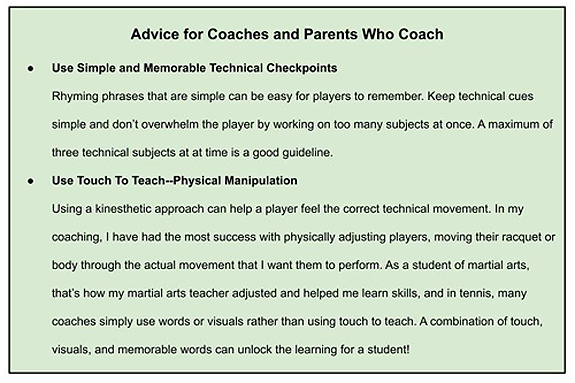
Technique Performed in a Drill is NOT Fully Learned
Contrary to many claims on YouTube videos, it's important to realize that technique formed in a drill is not fully acquired! A new stroke may look good and does indicate some initial success, but to fully bake in that technique the individual must demonstrate mastery in live ball exercises, point play, and then finally under the pressure of a match. Technique is fully learned when the player literally cannot remember how to perform his or her old technique and the player can perform the new technique automatically under the pressure of a match without any reversion to the old form.
Don't believe YouTube hype about successful technique changes! (Click Here to read John Yandell's take on YouTube miracle cures.)
Summary
Players and coaches should use the 1-2-3 process in the initial assessment of technique. First analyze the footwork, the handwork (strokes), and use video analysis to clarify what you think you are seeing.
Use the Winning Pretty Technique Prioritization Triangle as a guide to the ratio of types of technical training. The correct prioritization of strokes and movement is important to developing a world-class game or improving at any level. Follow the Five Stages of Technique Building on court to progress through the skill building process.
For coaches or parent-coaches, use simple and memorable technical checkpoints and don't work on too many subjects at once. Also use physical manipulation as a primary teaching tool. Remember that technique is NOT fully learned until it is performed in the heat of competition.
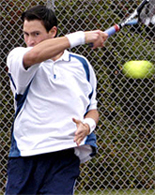
|
Chris Lewit is a leading high-performance coach, author, and educator. He is the author of the best-selling book Secrets of Spanish Tennis 2.0, which is now available, and a new technique book, Winning Pretty, which will be published by New Chapter Press in paperback in 2026. He is also a contributing editor for Tennisplayer.net magazine and a long-time member of the RSPA and PTR. As an educator, he has presented at several large conferences, including the PTR International Tennis Symposium. Chris studied religion and literature at Cornell, Harvard, and Columbia, and is currently pursuing a PhD in kinesiology and biomechanics. As a player, Chris Lewit played No. 1 for Cornell University and competed on the USTA and ITF pro circuits. As a coach, he has recently worked with several No. 1 junior players in the US and has trained hundreds of nationally ranked juniors. He directs a boutique full-time academy for homeschool/online players and a high-performance summer camp program, as well as high-performance training for all ages and levels, all at his club in the beautiful green mountains of Manchester, Vermont. Chris Lewit has a popular YouTube channel, Youtube.com/ChrisLewit, and you can follow his writing portfolio at https://medium.com/@ChrisLewit.
Chris Lewit Tennis Contact Chris directly by phone/WhatsApp at 914-462-2912 or chris@chrislewit.com. |
|



